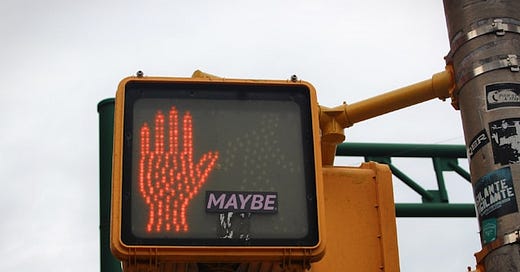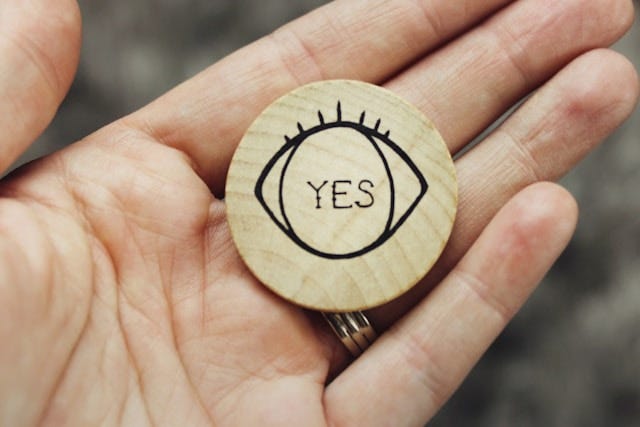What Makes Art Help Us Sometimes and Not Other Times?
Trigger stacking, decision fatigue, the window of tolerance and other factors that have made art not help me at certain times ...
I once asked informally on Instagram, are you more likely to create art when things are going well or going poorly, when you’re feeling terrific or feeling terrible. The answers were varied, from one end of the spectrum to the other. Sometimes, when things are not well, art helps us; sometimes when things are not well, we can’t create. What causes this difference - across individuals and within the same person?
Reflecting on my own creative life, I realize that I experience inconsistency in this. There have been times when depression was so overwhelming that creating art was the only way I felt remotely productive. Other times, depression manifested as days of sleep and zoning out in front of the TV, when the mere thought of crafting felt utterly overwhelming. Sometimes I can push through that inertia and create something, and other times, I can't, and I have to be gentle with myself.
But why is there this difference? What separates the famous artists who created their best work during their darkest times from those who fell into creative slumps due to mental illness? I’ve written often about how we exist on spectrums of both mental wellness and creative productivity. Sometimes, a strong creative drive can overcome mental health inertia—but not always. It’s inconsistent, unpredictable. There isn’t a clear line between being able to create and finding it too difficult, between art being healing and it being too much to handle.
Trigger Stacking and the Window of Tolerance
I’m not entirely sure if this is related or not, but I have been thinking about trigger stacking. Over the past couple of weeks, I’ve encountered a series of small annoyances: a clogged coffee maker, a grocery bag bursting open, my dog rolling in poop just as I realized I was out of dog shampoo, and slamming my thumb in a drawer. None of these incidents were significant individually, but together, they were overwhelming.
My brother often tells me that these are signs to slow down and be more mindful. He’s right; the coffee maker clogged because I hadn’t replaced the filter basket after washing it, and I missed my dog’s antics because I was texting while walking him. Slowing down and paying attention could have prevented these annoyances. However, it also made me think about trigger stacking, a concept from the dog world where small stressors accumulate, eventually leading to an outburst.
This idea is similar to the window of tolerance theory I learned in my trauma class. We all have a window of tolerance within which we function well. Some people have larger windows, while others have smaller ones, and our windows can fluctuate over time. When something pushes us out of this window, it takes time to return to a state of calm. In trauma, this often means swinging into anxiety or depression, and we need specific tools—downtime, safe spaces, deep breathing, or medication—to regain our balance.
I have developed this understanding after decades of lived experience, interview-based insights, and deep research into the complex relationship between art and health. They are based on my unique 6-part framework. If you are interested in assistance in applying these ideas to your own life: Order a Creative Health Assessment or Book a 1:1 Coaching Call.
Decision Fatigue
I think this all also relates to decision fatigue, where the sheer number of decisions we make daily wears us down. Even just the number of times per day that I think about what to eat is exhausting. One option is just to eat the same thing every day. By eliminating the need to decide what to eat, we conserve energy for other decisions.
How can I make decisions about creating art if I’ve already used up all of my decision energy for the day? Well, one answer is to create in the morning before I’ve used up that energy, which is something that I do. And another is to limit decisions with routine, including creative routines. And another is to try to tap into flow states with creativity where decisions aren’t part of the equation. And another is to follow patterns (such as in crochet or paint by number) or establish a specific creative plan that you’ll follow.
So … there are lots of reasons art helps us sometimes and not other times.
Sometimes art doesn’t help because I’m already too exhausted from the cumulative stress of life—trigger-stacked, outside my window of tolerance, or overwhelmed by decision fatigue. On those days, the effort to retrieve art supplies feels daunting, as though they might fall on my head.
To overcome these barriers on difficult mental health days, it helps to have craft projects prepped and ready to go. For example, crochet is excellent for me because I can follow a pattern without making many decisions. During a depressive episode, I made several large granny square blankets; the yarn was already out, and the process required minimal effort, which made it possible to create and find some relief.
There’s value in removing obstacles to starting art on challenging days. Preparing project bags with all necessary supplies—like a pattern, yarn, and hook for crochet, or a sketchbook and pencils for drawing—can make it easier to begin creating.
However, if I’m too far gone, I might need to wait for my mind and body to regulate before even taking those steps. Sometimes depression looks like spending a day in bed with repetitive TV and simple video games because that’s all my brain can handle. I used to be hard on myself during these days—sometimes, I still am. But I’ve come to accept that there are times when this is what my brain needs. While I must be careful that one day in bed doesn’t turn into several, I also allow myself that time to rest.
From there, I can take baby steps—deep breathing, switching from TV to podcasts or music, getting outside for a walk, looking at art, and eventually, creating something myself.
What are your thoughts? How do mental health challenges affect your ability to create, and when does art help with those symptoms? When does art not help?
If you read this far, perhaps you liked the work. The work does take work. It only continues with support, so please consider subscribing. My annual rate starts at $10 per year.









Kathryn, I've been going through a lot of overwhelm in the past few weeks. Little things are triggering, too many things decisions to make and tasks to do that are clogging up my mind making it harder to writer and be creative. Right now the biggest fix for me with my GAD and situational depression has been walking. If I can't really concentrate on my art because I am stuck in worry mode, I find it hard to be creative.
I like the idea of having materials ready when depressed. It certainly helps, because I don’t have to expend a lot of energy I don’t have .